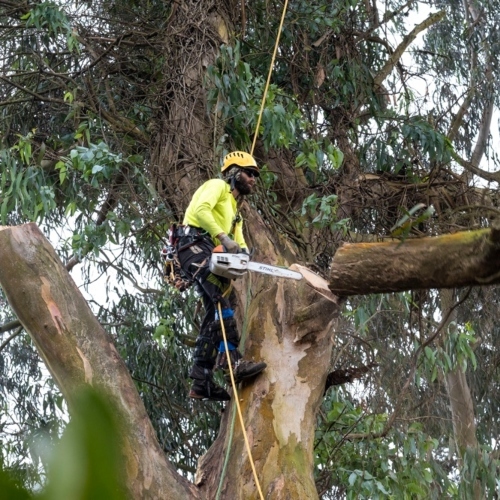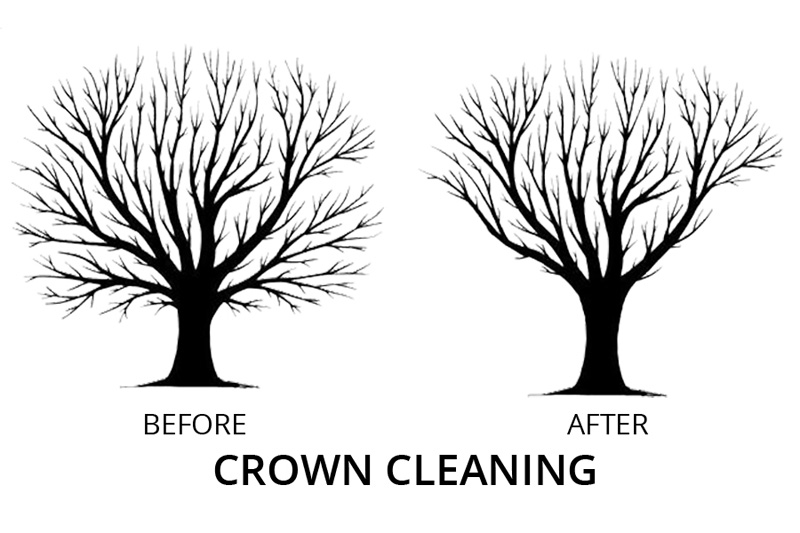Pruning the Street Trees of San Francisco
Introduction
Though it may seem simple, tree pruning is actually extremely complicated, technical, and dangerous.
As a homeowner, you want your property to exemplify San Francisco’s deserved reputation for beautiful trees, such as the cork oak and Bailey’s acacia , and also its spectacular park lands. If your home is your castle, then your yard is your realm. The same can be said of commercial property managers and municipalities—it is not simply the structures that require care and maintenance. The surrounding areas need just as much upkeep to preserve a welcoming appearance and safe setting—particularly if there are trees on the property.
Tree pruning or tree trimming is the most common tree care service and should be left to a professional arborist. An “arborist,” you say? Sounds a little urbane, doesn’t it? When you think of tree climbers, you may think of a lumberjack dressed in a red flannel shirt with a blue ox companion. Actually, an arborist is a specialist in the care and maintenance of trees. Though they may fell trees, arborists are also experts on tree surgery, on the diagnosis, treatment and prevention of tree diseases, and on control of pests.
Even if you are an accomplished DIYer, the one task not recommended to perform yourself is pruning trees and shrubs. Here are the reasons why it’s best to leave your tree pruning and shrub pruning to the pros and hire Arborist Now for all of your tree care needs:
Tree Pruning is a Dangerous Job

An Arborist Now Professional Using Proper Tools & Safety Gear While Pruning
The necessary equipment alone is an eye-opener and not for the fainthearted—simply consider the ladders and hand saws and chainsaws! Combine these and toss in heights and the physical effort needed to utilize the equipment, and it becomes fairly obvious why pruning trees has a high injury rate. The US Bureau of Labor Statistics lists tree pruning as one of the most dangerous jobs in the workforce, so it’s easy to imagine the dangers that await an amateur.
Hazards to Homeowners
One of the main factors contributing to this danger is that the average homeowner cannot easily distinguish a rotten branch from a healthy one. If a person transfers their weight onto a rotten branch, it could give way beneath, causing serious injury, possibly death, or major damage to property and to the tree itself. Furthermore, tree pruning requires the use of sharp tools at elevated heights. Special safety precautions to coordinate the use of a chainsaw while standing on a ladder are not common knowledge for the average homeowner. Arborists have the tools, training, and safety equipment needed to prune trees effectively and safely.
Unpredictable Threats to Property
Tree stability can be unpredictable, and the limbs are liable to fall in unpredictable manner. Once a branch is cut, it may fall in an unexpected way and cause grave injury to someone nearby, crush the roof of a car, or seriously damage another structure. Arborists are trained to properly assess, plan, and carry out pruning projects without causing property damage. Additionally, arborists are insured and bonded, so any unforeseen costs to your home are covered.
Poor Pruning Techniques
Amateur pruning may cause future damage, danger, and decreased property values. Trees and shrubs require consistent, expert pruning for proper health and strength. Trees that have not been properly pruned are often weakened and become hazardous. It is possible that a single strong gust of wind could blow down a branch or a whole tree that has not been properly pruned. An unfortunate example is ” tree topping ,” the highly discouraged practice of trimming off a significant portion of the tree’s crown under the myth that it will encourage additional branches to grow. The result is a sadly deformed tree that is severely weakened. It is more likely to develop disease and rot, becoming an unsightly hazard.
Top Three Pruning Techniques
Crown Cleaning
Crown cleaning is the process of removing certain branches of a tree to reduce the risk of falling branches and tree decay that may lead to the removal of the tree. This method consists of selecting and removing branches showing signs of decay or disease. Tree cleaning is preferred for older trees because it does not unnecessarily remove healthy tree branches.

An Example of Before & After Tree Crown Cleaning
Crown Thinning
Crown thinning is performed to increase sunlight exposure and clear air passages around a tree. This method involves reducing the density of the tree branches by selectively pruning branches at the crown of the branch as opposed to its interior. Most often, this method is used to improve the landscaping aesthetic and allow property owners receive more natural sunlight into their structures.

An Illustration Demonstrating Before & After Tree Crown Thinning
Structural and Safety Pruning
Structural and safety pruning is performed to reduce height or spread of a tree. This method of tree pruning is most often done to make a path for a utility line or to clear vegetation away from buildings. One thing to note with reducing trees is that not every tree can handle this type of pruning, so the overall health of the tree needs to be considered before starting. This method is utilized when tree growth is a safety hazard for people, property, utilities, traffic, or other potentially dangerous situations.
Safety—first and foremost!
At Arborist Now, we cannot overemphasize safety! The very nature of tree work—climbing great heights, exposure to electrical hazards, the potential for property damage or possible injury to a pedestrian or an employee—means that safe work practices are routine and training is paramount. We adhere to safety regulations established by OSHA and ANSI. These regulations outline best practices related to climbing, electrical hazards, personal protective equipment, proper rigging, aerial rescue, and property protection. Again—safety is first and foremost!
A YouTube Video Covering Arborist Now’s Commitment to Quality & Safety
Cleanup and Recycling after Tree Pruning
Once trees or shrubs are pruned, there are options for debris cleanup and removal. We are happy to tailor our cleanup and recycling services to meet your specific needs. Arborist Now debris cleanup services include:
- Complete removal of all debris with raking, moving the debris offsite, and clearing walkways, driveways, and roofs
- Log removal
- Cutting the wood to various lengths for firewood
- Brush chipping for removal or to be left in piles at property owner’s discretion
- Moving wood to a desired location
- Working with existing employees/contractors

Our Certified Arborists Performing Sidewalk Cleanup After a Pruning Job
Conclusion
The smart homeowner recognizes personal limitations and the dangers of DIY tree and shrub pruning. Poor pruning done by a novice undermines the value of your landscape and detracts from its overall appeal. Having a certified arborist do the pruning actually protects you, your home, your family, and the tree.
The experts at Arborist Now are proficient in tree pruning services and all other tree care and maintenance needs for residential, commercial, municipal, and institutional properties— contact us today !
Originally published on August 1, 2017.


